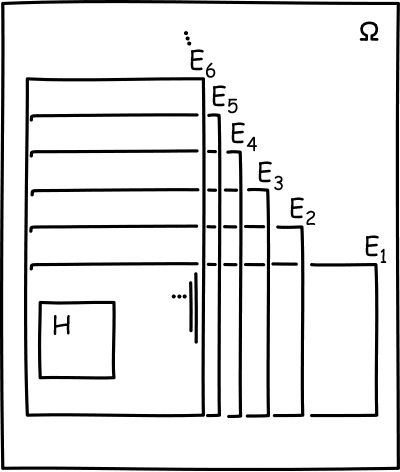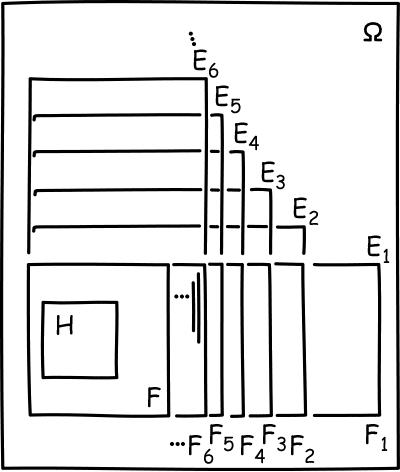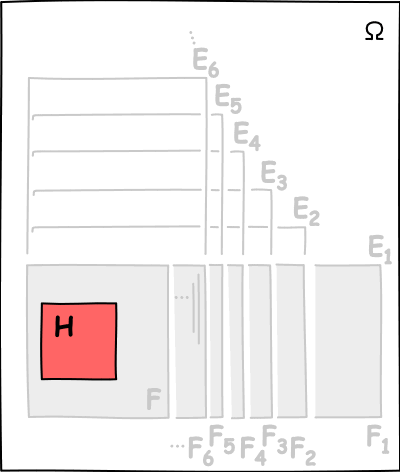| 0 | 1 | 2 | 3 | 4 | 5 | 6 | 7 | 8 | 9 |
What Logics of
Induction are There?
John D. Norton |
7. A Limit Theorem
There is a familiar limit theorem in
Bayesian confirmation theory. It arises when we have an hypothesis H
that deductively entails n items of evidence, E1, E2,
... ,En. If the prior probability P(H)>0, it is fairly easy to
show that
P( En | E1 & E2 &
... & En-1 ) approaches 1 for large n.
This is a strong and even astonishing result. Pick some
hypothesis that has infinitely many deductive consequences. While we may not
know if the hypothesis is true, assume that we find it reasonable enough to
give it some non-zero prior probability, no matter how small. That is enough
to make us inductively audacious and even brazen
about its consequences. While we learn the truth of some of the consequences,
we will become successively more sure of the truth of the next as yet
untested consequence. As this process continues we become more sure without
limit; we need only to have finitely many successes before we
become arbitrarily sure that the next untested consequence will prove
true.
A fact about the deductive structure ...
This theorem and the generalization to be developed here
express a fact about the deductive relations among H and E1,
E2, ... , En. To see that fact, we need to define some
auxiliary propositions:
F1 = E1
F2 = E1 & E2
F3 = E1 & E2 & E3
...
Fn = E1 & E2 & ... &
En
Since H entails each of E1, E2, ...
,En, it follows that
H entails Fn entails Fn-1 entails ...
entails F2 entails F1
This means that the number of atoms is non-decreasing as we
proceed along the sequence
#H <
#Fn <
#Fn-1 < ...
< #F2 < #F1
This is combined with a simple relation among the ratios of
these atoms:
(#H/N) = (#H/#Fn) x
(#Fn/#Fn-1) x (#Fn-1/#Fn-2) x ...
x (#F3/#F2) x (#F2/#F1) x
(#F1/N)
From this last relation, we arrive at the
important fact about the deductive structure, if we consider what
happens as the number n of propositions Fn grows. On the
right hand side we are multiplying together a growing number of
factors of the form (#Fi/#Fi-1). Each of these
factors is less than or equal to unity. So their product will approach zero, in general, thereby
forcing (#H/N) to approach zero as well.
If, however, we also require that (#H/N) approaches a stable value
greater than zero, then we must have the one case in which the
growing product on the right hand side does not approach zero. That
case arises only if the ratio of atoms
(#Fn/#Fn-1) approaches 1. |
If (#H/N) approaches a stable value greater than zero,
then #Fn approaches #Fn-1 for large n.
... re-expressed in the inductive logic
The basic fact is that the propositions Fn and
Fn-1 approach one another in the natural measure of their atom
counts. Any logic of induction that measures support through these these
atoms counts must then reflect that approach in a
corresponding approach of strengths of support. That will be the inductive
limit theorem. This theorem appears in the inductive logics under
consideration here. They are inductive logics that are asymptotically stable
and deductively definable in preferred partitions. To find the theorem, let
us consider the above fact in the context of the preferred
partitions of this logic.
First we will assume that H has a non-zero generalized
prior. That means that the limiting value of [ H |
Ω ] as we proceed to larger partitions must differ from the
minimal support [ contradiction | Ω ] that a contradiction is accorded
by the background Ω. Closer examination of the continuity of the logic
(given in the full paper) shows that this means that the ratio #H/N must
approach a value greater than zero.
It now follows that #Fn approaches
#Fn-1. If the inductive logic obeys the natural sense of
continuity of the full paper, that means that
[ Fn | Fn-1 ] approaches [
Fn-1 | Fn-1 ] for large n.
However we expect that anything gets certain support from
itself, so [ Fn-1 | Fn-1 ] equals "certainty," which is
the maximum level of support. Combining, we have the most general form of the limit theorem:
If [ H | Ω ] approaches a stable value that exceeds
the minimal value,
then [ Fn | Fn-1 ] approaches certainty for large n.
This form of the limit theorem does not quite match the
original Bayesian version. That is because the Bayesian system conforms to a
particular property of some inductive logics, "Narrowness." As defined earlier, that property tells us that
[A&B|B] = [A|B]. Applying it to [ Fn | Fn-1 ] we
find
[ Fn | Fn-1 ]
= [ E1 & E2 & ... &En-1 &
En | E1 & E2 & ... &
En-1 ]
= [ En | E1 & E2 & ...
& En-1 ]
Thus the limit theorem now
becomes
If [ H | Ω ] approaches a stable values that exceeds
the minimal value in a narrow logic,
then [ En | E1 & E2 & ...
& En-1 ] approaches certainty for large n.
Illustrated
It is quite informative to illustrate
the limit process in a Venn diagram.
Below is the process showing the sequence of propositions
E1, E2, ... ,En. The essential point
about the sequence is that the individual terms of the sequence of
conjunctions E1, E1 & E2,
E1 & E2 & E3,... must always
contain H. That means they must approach a
limit proposition entailed by H, not shown in the figure
below, but shown in the next figure at right. |
That limiting proposition (which may
never be realized in a finite algebra) is denoted by F below. It is
more easily visualized as the limit of the sequence of conjunctions
F1, F2, ... ,Fn.
The essential deductive fact expressed in the limit theorem is that
the successive terms of the sequence of conjunctions approach one another arbitrarily closely in
their atom counts as that limit is approached.
Since the degrees of support are defined in terms of atom counts,
that approach must then also be reflected in an approach of inductive
strengths. |
 |

|
To get the full experience, you need to see the
animation of the approach to this limit.

| 0 | 1 | 2 | 3 | 4 | 5 | 6 | 7 | 8 | 9 |
What Logics of
Induction are There?
John D. Norton |


